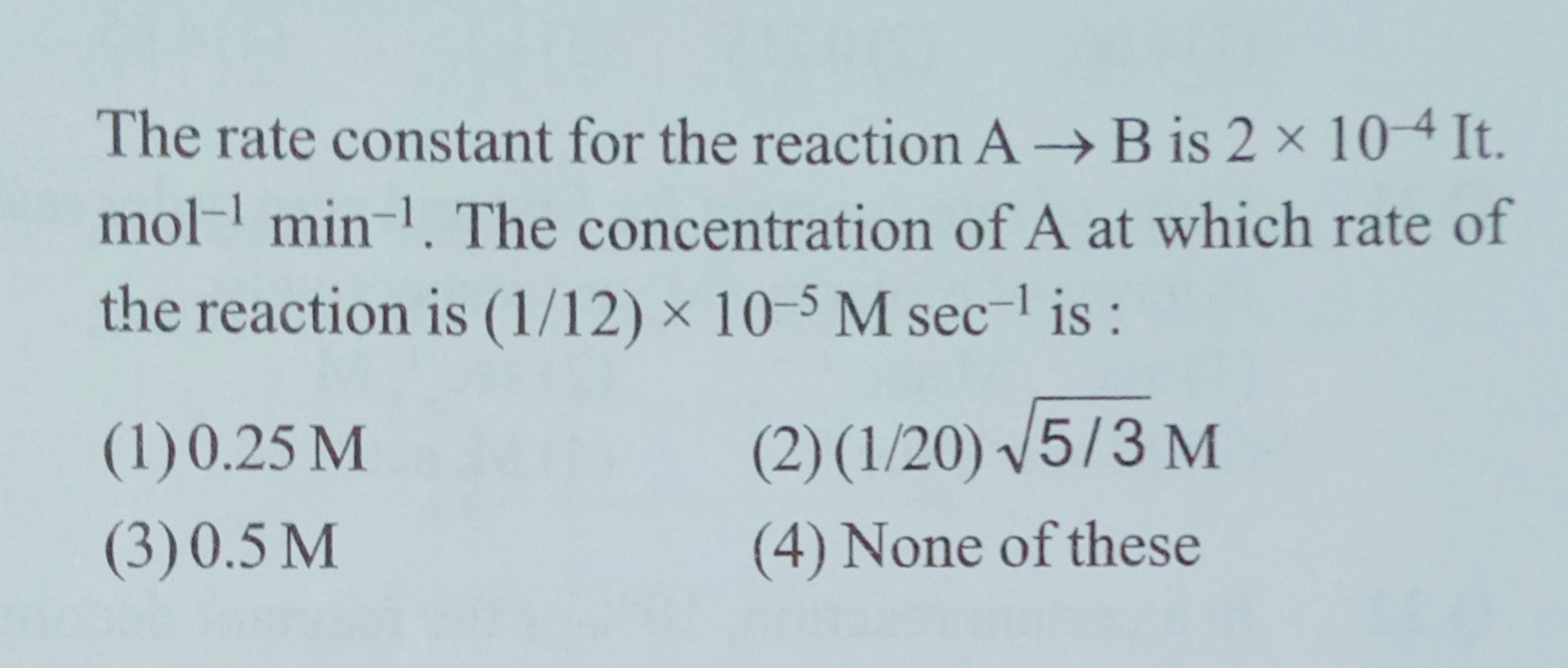Question
Question: The rate constant for the reaction A→B is 2 × 10⁻⁴ It. mol⁻¹ min⁻¹. The concentration of A at which ...
The rate constant for the reaction A→B is 2 × 10⁻⁴ It. mol⁻¹ min⁻¹. The concentration of A at which rate of the reaction is (1/12) × 10⁻⁵ M sec⁻¹ is :

0.25 M
(1/20) 5/3 M
0.5 M
None of these
0.5 M
Solution
The given reaction is A → B. The rate constant for the reaction is k=2×10−4 L mol⁻¹ min⁻¹. The unit of the rate constant is L mol⁻¹ min⁻¹, which can be written as (mol/L)⁻¹ min⁻¹ or M⁻¹ min⁻¹. For a reaction of order n, the unit of the rate constant is (concentration)¹⁻ⁿ (time)⁻¹. Comparing the given unit M⁻¹ min⁻¹ with M¹⁻ⁿ min⁻¹, we get 1 - n = -1, which means n = 2. Thus, the reaction is a second-order reaction with respect to A. The rate law for the reaction is given by:
Rate = k[A]²
We are given the rate of the reaction as Rate = (1/12) × 10⁻⁵ M sec⁻¹. The rate constant is given in min⁻¹, while the rate is given in sec⁻¹. To use the rate law, we need to have consistent time units. Let's convert the rate constant from min⁻¹ to sec⁻¹.
1 minute=60 seconds.
So, 1 min−1=601 sec−1.
k=2×10−4 M−1 min−1=2×10−4 M−1×601 sec−1
k=602×10−4 M−1 sec−1=301×10−4 M−1 sec−1
k=31×10−5 M−1 sec−1.
Now, we can use the rate law Rate = k[A]² and the given rate to find the concentration of A, [A].
(1/12) × 10⁻⁵ M sec⁻¹ = (31×10−5 M⁻¹ sec⁻¹) × [A]²
Rearranging the equation to solve for [A]²:
[A]² = (1/3)×10−5 M−1 sec−1(1/12)×10−5 M sec−1
[A]² = 1/31/12×10−510−5×M−1 sec−1M sec−1
[A]² = 121×3×1×M1−(−1)×sec−1−(−1)
[A]² = 123×M2×sec0
[A]² = 41 M2
[A]² = 0.25 M²
Now, take the square root to find [A]:
[A] = 0.25 M2
[A] = 0.5 M
The concentration of A at which the rate of the reaction is (1/12) × 10⁻⁵ M sec⁻¹ is 0.5 M.
